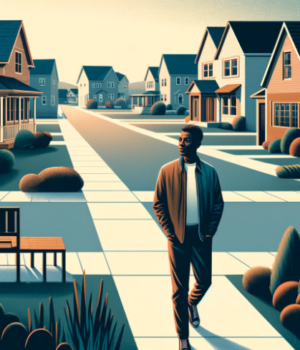# Man Shares Viral Experience of Navigating Race in White Neighborhood
In a world where conversations about race and inclusion are more relevant than ever, one man’s experience of taking “a black walk” in a predominantly white neighborhood has sparked widespread conversation. The story has gone viral, offering a raw and insightful perspective on the complexities of navigating race in spaces where you don’t always feel like you belong. His poignant words are not just a recount of an incident—they serve as a wake-up call for those who may never have considered the invisible struggles that come with being a minority.
Below, we delve into this powerful story, unpack the lessons it offers, and explore the broader issues of community, privilege, and understanding.
## The Story That Captivated Thousands
The incident began simply: a man—a Black man—decided to take a walk in a white neighborhood. As he strolled past manicured lawns, picket fences, and quiet homes, a single, persistent thought occupied his mind.
He wondered, *“What do they think when they see me?”*
His viral post chronicled the many micro-decisions he had to make during that walk. From the clothes he chose to wear to the pace at which he walked, each moment was layered with caution and a need to appear as “non-threatening” as possible.
In his words:
“I found myself rehearsing my every move. Walk slow, but not too slow. Don’t look at any houses for too long. Smile—but not too much. No hoodie. Keep your hands where people can see them.”
For many readers, these precautions were a revelation. For others, they were a painful reminder of the vigilance that often accompanies everyday activities for people of color.
### Why His Story Resonated with So Many
The reason behind his story’s virality is rooted in how deeply it resonated with people across the world. For minorities, it provided a relatable and validating voice to an all-too-common experience. For others, it was an eye-opener—a glimpse into a perspective they had never considered before.
Here’s why this story struck a chord:
## The Invisible Burden of “Code-Switching”
One of the most impactful aspects of his post was the detailed account of what many scholars refer to as “code-switching.” This term describes when people of color feel the need to change their behavior, language, or mannerisms to adapt to majority spaces.
During his walk, code-switching became second nature.
For instance:
His post illustrated how exhausting it can be to constantly curate yourself in predominantly white spaces—a reality many minorities understand but rarely articulate publicly.
### The Weight of “Appearances”
What struck readers most was how much effort the man put into appearing “harmless.” Every choice he made during that walk—down to the smallest detail—reflected his awareness of stereotypes and the potential dangers they pose.
For example:
“I thought about wearing athletic gear so it looked like I was out for a jog, but then I remembered that even joggers like Ahmaud Arbery aren’t safe in certain neighborhoods,” he wrote.
This chilling reflection not only referenced recent tragedies but also underscored a larger, ongoing issue: the criminalization of Black bodies in everyday spaces.
## A Window Into Privilege
Another reason why his story went viral is how it illuminated privilege in a way that felt impossible to ignore. For many white readers, the ability to take a walk without second-guessing their attire, route, or behavior was something they had always taken for granted.
Privilege is often invisible to those who have it, and his story brought it into stark relief. It reminded readers that freedom of movement is not always equal and that some people must navigate a world filled with unspoken rules and risks.
### How to Recognize Privilege in Everyday Life
Here are a few ways his story encouraged readers to reflect on their own privilege:
## The Movement Towards Change
While the man’s story highlighted the struggles that people of color face, it also inspired hope. Thousands of readers commented on the original post, sharing their own experiences or vowing to be more mindful moving forward.
The virality of this story has spurred conversations on real, actionable change. Communities are beginning to evaluate:
Change often begins with awareness, and his story has certainly made an impact in that regard.
### The Power of Sharing Stories
This episode reminds us of the transformational power of storytelling. When one person dares to share their reality, it often encourages others to do the same, creating a ripple effect of awareness and understanding.
In this case, the man’s vulnerability paved the way for tougher but necessary conversations about race.
## Final Thoughts: Creating a More Inclusive World
The story of a single walk through a white neighborhood has sparked dialogue, opened eyes, and challenged assumptions. It reminds us that the world isn’t always as inclusive as it could—or should—be.
But it also offers hope. By listening, empathizing, and reflecting on what privilege means in our daily lives, we can make meaningful changes that ensure everyone feels safe, respected, and welcome.
### A Challenge to Readers:
After reading his story, take a moment to reflect on your own community.
– Are there hidden biases you need to address?
– How can you be more proactive in creating an inclusive environment?
Because, ultimately, meaningful change begins with all of us.








